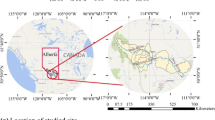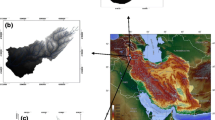Abstract
Runoff forecasting is essential for the reasonable use of regional water resources, flood prevention, and mitigation, as well as the development of ecological civilization. Runoff is influenced by the intersection of many factors, and the change process is extremely complex, showing significant stochasticity, nonlinearity, and heterogeneity, making traditional prediction models less adaptable. The Hodrick–Prescott filter (HP filter) is a well-established signal separation method. The traditional GM(1,1) model is capable of portraying the growth trend of the time series but cannot capture the periodic characteristics of the time series. Therefore, a novel coupled prediction model-HPF-GM(1,1) model is proposed in this study and applied to the runoff prediction of the Zhuzhou section of Xiangjiang River in Hunan Province. This model enables to separate seasonal factors from non-seasonal factors in the runoff time series, and introduce seasonal factors based on the traditional GM(1,1) model, which solves the challenge that the traditional GM(1,1) model is unable to predict seasonal time series. The results show that the HPF-GM(1,1) model has a mean relative error of 4.82%, a root mean square error of 7.44, and a Nash efficiency coefficient of 0.93, which is better than the traditional GM(1,1) model, the DGGM(1,1) model and the SGM(1,1) model of prediction accuracy. Obviously, the HP filter provides a new approach to data pre-processing of runoff series and the proposed HPF-GM(1,1)-coupled model extends new ideas for nonlinear runoff prediction.
Graphical abstract








Similar content being viewed by others
Data availability
Datasets and other materials are available with the authors, and may be accessible at any time upon request.
References
Bahrami S, Hooshmand RA, Parastegari M (2014) Short term electric load forecasting by wavelet transform and grey model improved by PSO (particle swarm optimization) algorithm. Energy 72:434–442
Chen JL, Liu YF, Qian J, Yu DH (2018) Annual runoff inflow into Yuanyangchi reservoir prediction based on the combination of R/S analysis and GM(1,1) grey model. J Water Resour Water Eng 29: 148–153+158
Dong S, Chi K, Zhang ZX (2012) The application of a Grey Markov Model to forecasting annual maximum water levels at hydrological stations. J Ocean Univ Chin 11:13–17
Esmaeili F, Shabanlou S, Saadat M (2021) A wavelet-outlier robust extreme learning machine for rainfall forecasting in Ardabil City, Iran. Earth Science Informatics. 14(4):2087–2100
Elshaboury N, Elshourbagy M, Al-Sakkaf A, Abdelkader EM (2021) Rainfall forecasting in arid regions using an ensemble of artificial neural networks. J Phys: Conf Ser 1:1900
Hodrick RJ, Prescott EC (1997) Postwar US business cycles: an empirical investigation. Money Credit Bank 1997:1–16
Kong FB, Zhao B, Xu XY, Men XJ, Bai B (2017) Monthly runoff forecasting model based on support vector machine and grey prediction agorithm. Int J Comput Eng 2:57–59
Li DY, Sun YQ, Yin KL (2019) Displacement characteristics and prediction of Baishuihe landslide in the Three Gorges Reservoir. J Mt Sci 16:2203–2214
Wu L, Zhou H (2010) Urban water demand forecasting based on HP filter and fuzzy neural network. J Hydroinf 12(2):172–184
Liu XH, Liu B, Zhang GL (2021a) Analysis on forecast of annual runoff of Kumarak River based on optimized grey model. China Resour Compr Utilization 39:17–22
Liu C, Ma LX, Pan JF, Ma Z (2021b) PD signal denoising based on VMD and improved wavelet threshold. Mod Electron Tech 44:45–50
Liu SF, Deng JL (1982) The range suitable for GM(1,1). Syst Eng-Theory Pract 05:121–124
Luo D (2014) Risk evaluation of ice-jam disasters using gray systems theory: the case of Ningxia-Inner Mongolia reaches of the Yellow River. Nat Hazards 71(3):1419–1431
Phillips PCB, Jin S (2021) Business cycles, trend elimination, and the HP filter. Int Econ Rev 62:469–520
Qi TH (2021) Forecasting stock price with grey model and ARIMA model. Computer Era 10: 83–85+89
Rajagopal R, Rajendran C (2019) Grey- and rough-set-based seasonal disaster predictions: an analysis of flood data in India. Nat Hazards 97:395–435
Shahid M, Cong Z, Zhang D (2018) Understanding the impacts of climate change and human activities on streamflow: a case study of the Soan River basin. Pak Theor Appl Climatol 134(1):205–219
Shahid M, Rahman KU, Haider S, Gabriel HF, Khan AJ, Pham QB, Pande CB, Linh NT, Anh DT (2021) Quantitative assessment of regional land use and climate change impact on runoff across Gilgit watershed. Environ Earth Sci 80(22):1–8
Siqueira AHB, Molion LCB (2015) Climate analysis: the Hodrick-Prescott filter applied to Southern Oscillation index and North Atlantic Oscillation index. Rev Bras Meteorol 30(3):307–318
Wu GZ, Wang C (2020) Research on runoff grey prediction based of improved fitting. Yellow River 42:34–36+41
Wang QR, Liu L, Wang S, Wang JZ, Liu M (2017a) Predicting Beijing’s tertiary industry with an improved grey model. Appl Soft Comput 57:482–494
Wang ZX, Li Q (2019) Modelling the nonlinear relationship between CO2 emissions and economic growth using a PSO algorithm-based grey Verhulst model. J Clean Prod 207:214–224
Wang ZX, Li Q, Pei LL (2018) A seasonal GM(1,1) model for forecasting the electricity consumption of the primary economic sectors. Energy 154:522–534
Wang ZX, Li Q, Pei LL (2017b) Grey forecasting method of quarterly hydropower production in China based on a data grouping approach. Appl Math Model 51:302–316
Xia M, Wong WK (2014) A seasonal discrete grey forecasting model for fashion retailing. Knowl-Based Syst 57:119–126
Xiao XP, Yang JW, Mao SH, Wen JH (2017) An improved seasonal rolling grey forecasting model using a cycle truncation accumulated generating operation for traffic flow. Appl Math Model 51:386–404
Xu WJ, Gu R, Liu YZN, Dai YW (2015) Forecasting energy consumption using a new GM-ARMA model based on HP filter: the case of Guangdong Province of China. Econ Modell 45:127–135
Yuan HC, Song QQ, Deng ZY, Fu X (2018) Yellow River’s annual runoff cycle model and prediction based on grey relational degree. Yellow River 40:17–20
Zhang XQ, Wu XL, He SY (2021) Precipitation forecast based on CEEMD–LSTM coupled model. Water Supply 21(8):4641–4657
Zhou ZH, Liu JJ, Yan ZQ, Wang H, Jia YW (2021) Attribution analysis of the natural runoff evolution in the Yellow River basin. Adv Water Sci 33(01):27–37
Zhu XM, Zhu YS, Luan WX (2012) Frequency domain characteristics of macroeconomic time series and the choice of HP filter smoothing parameters. Stat Decision 05:7–11
Funding
The authors wish to thank the Key Scientific Research Project of Colleges and Universities in Henan Province (CN) [grant number 17A570004] for the collection, analysis, and interpretation of data.
Author information
Authors and Affiliations
Contributions
Zhang XQ: methodology, investigation, and writing—original draft preparation. Wu XL: conceptualization and writing review and editing. Xiao YM: methodology and formal analysis. Shi JW: conceptualization and writing—original draft preparation. Zhao Y: conceptualization, resources, and formal analysis. Zhang MH: methodology and project administration.
Corresponding author
Ethics declarations
Ethics approval
This paper does not contain any studies with human participants or animals performed by any of the authors.
Consent to participate
Consent.
Consent for publication
Consent.
Competing interests
The authors declare no competing interests.
Additional information
Responsible Editor: Marcus Scshulz
Publisher's note
Springer Nature remains neutral with regard to jurisdictional claims in published maps and institutional affiliations.
Highlights
1. The runoff process is influenced by many factors, which makes accurate prediction of it particularly difficult. Therefore, we have chosen to investigate the changes in the runoff volume of the Xiangjiang River from 1980 to 2019.
2. The HP filter can decompose the original data into trend and cycle components, innovatively coupling the HP filter with a GM(1,1) model. The coupled model does not merely capture the trend signal of the runoff time series but also the seasonal signal.
3. The HP-GM(1,1) model has better prediction accuracy than the traditional GM(1,1) model, DGGM(1,1) model and SGM(1,1) model. It has the potential to be extended to other regions, expanding new ideas for nonlinear runoff prediction.
Rights and permissions
About this article
Cite this article
Zhang, X., Wu, X., Xiao, Y. et al. Application of improved seasonal GM(1,1) model based on HP filter for runoff prediction in Xiangjiang River. Environ Sci Pollut Res 29, 52806–52817 (2022). https://doi.org/10.1007/s11356-022-19572-6
Received:
Accepted:
Published:
Issue Date:
DOI: https://doi.org/10.1007/s11356-022-19572-6




